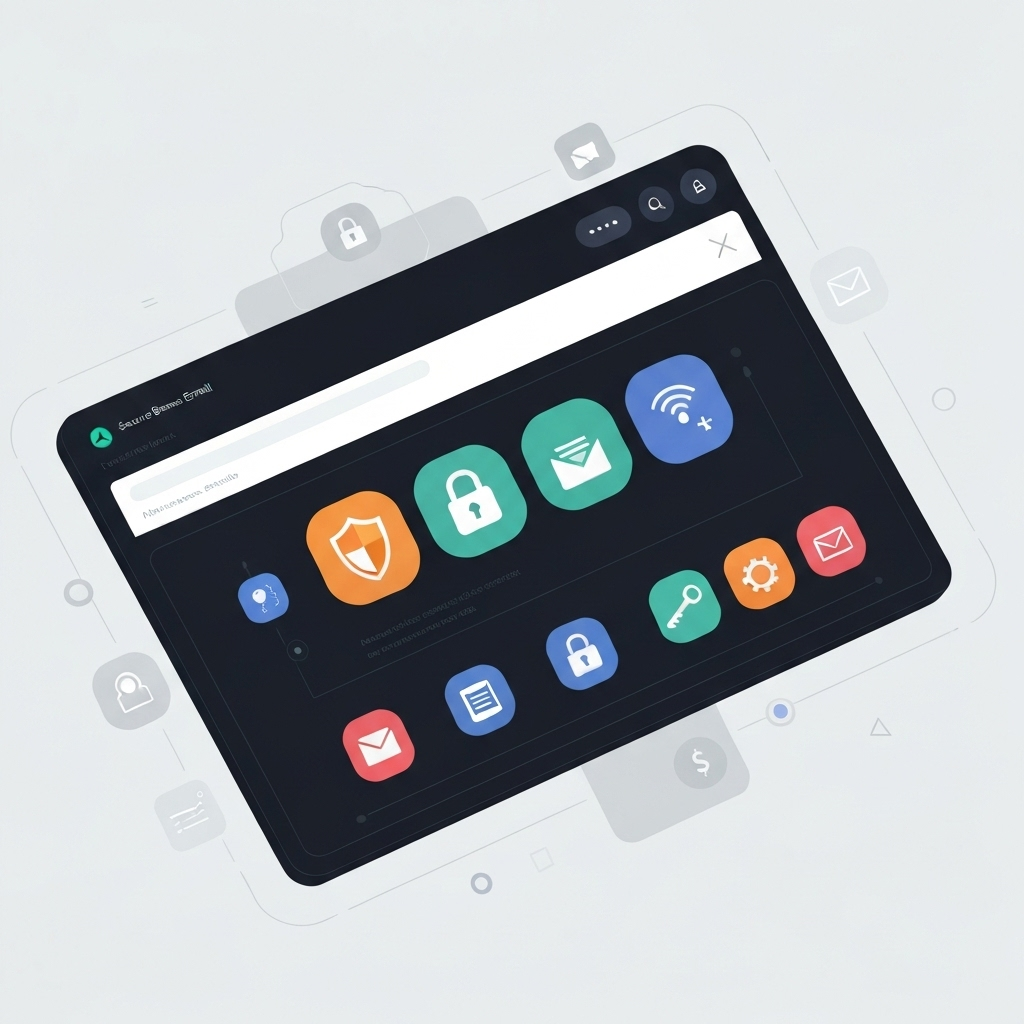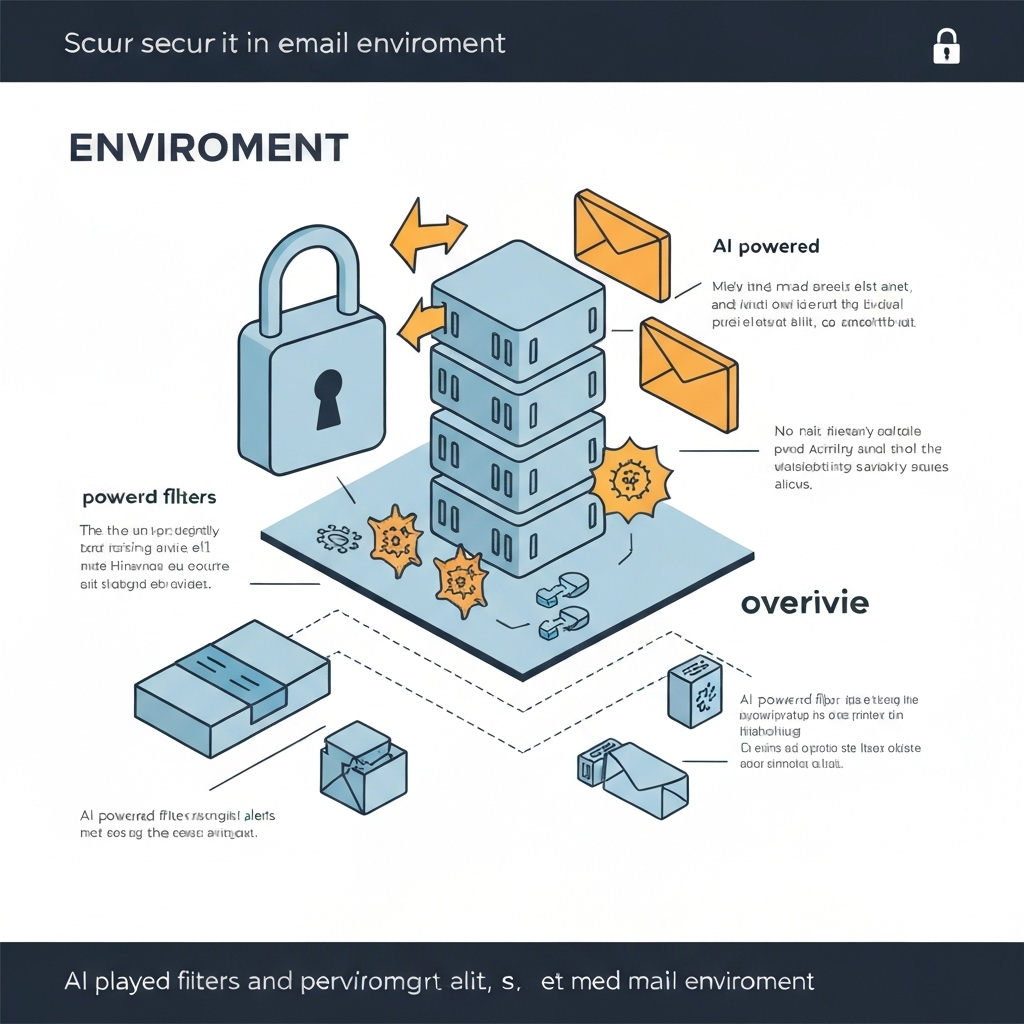Secure Business Email: AI Protection for Your Inbox

In today's hyper-connected business landscape, email remains the lifeblood of communication. From client interactions and internal team coordination to critical transaction confirmations and sensitive data exchange, your inbox is a central hub. However, this essential tool is also a prime target for cybercriminals. The consequences of a compromised business email can range from minor disruptions to catastrophic data breaches, reputational damage, and significant financial losses. Fortunately, the evolution of technology, particularly artificial intelligence (AI), is revolutionizing how we approach secure business email, offering unprecedented levels of protection and efficiency.
Understanding the Threats: Common Security Risks in Business Email
Before diving into solutions, it's crucial to understand the landscape of threats that target business email. Cybercriminals are constantly innovating, developing sophisticated methods to infiltrate inboxes and exploit vulnerabilities. These threats aren't just nuisances; they can cripple operations and compromise sensitive information.
Phishing and Spear Phishing
Phishing attacks are designed to trick recipients into revealing sensitive information, such as login credentials or financial details, by impersonating legitimate entities. Spear phishing takes this a step further, tailoring attacks to specific individuals or organizations, making them far more convincing. These emails often contain malicious links or attachments.
Malware and Ransomware
Malicious software (malware) can be delivered via email attachments or links. Once executed, it can steal data, disrupt systems, or grant attackers remote access. Ransomware, a particularly damaging type of malware, encrypts a victim's files and demands a ransom payment for their decryption. A successful ransomware attack can halt business operations entirely.
Business Email Compromise (BEC)
BEC attacks are highly targeted and often involve impersonating executives or trusted partners. Attackers might request urgent wire transfers, payroll changes, or sensitive employee data. These scams rely on social engineering rather than technical exploits and can be incredibly difficult to detect without advanced analytics.
Spoofing and Impersonation
Email spoofing allows attackers to alter the sender's email address, making it appear as if the email originated from a trusted source. This is commonly used in phishing and BEC attacks to build credibility and bypass initial security filters.
Spam and Unwanted Mail
While often seen as just an annoyance, excessive spam can clog inboxes, waste employee time, and sometimes mask more malicious content. Unmanaged spam can lead to missed important communications.
Data Leakage and Exfiltration
Accidental or malicious sending of sensitive company data outside the organization through email is a significant risk. This can violate privacy regulations and expose confidential business strategies or customer information.
Why Secure Business Email is Non-Negotiable for Today's Businesses
In an era where data is a valuable asset and trust is paramount, maintaining a secure business email system is not just a best practice; it's a fundamental requirement for survival and growth. The risks associated with insecure email extend far beyond immediate financial loss.
Maintaining Customer Trust and Reputation
A data breach originating from an email compromise can severely damage your company's reputation. Customers entrust businesses with their personal and financial information. If this trust is broken due to a security lapse, rebuilding it can be an arduous and costly process. A strong stance on business email protection demonstrates a commitment to safeguarding client data.
Ensuring Regulatory Compliance
Numerous regulations, such as GDPR, HIPAA, and CCPA, mandate strict data protection and privacy standards. Failure to comply can result in hefty fines, legal action, and further reputational damage. A secure email infrastructure is essential for meeting these compliance obligations, particularly concerning email data privacy.
Preventing Financial Losses
The direct financial impact of email-related cyberattacks can be staggering. This includes losses from fraudulent transactions (BEC), costs associated with recovering from ransomware attacks, expenses for incident response and forensic analysis, and potential legal settlements. Investing in robust security can yield a significant return on investment by preventing these costs.
Protecting Intellectual Property and Trade Secrets
Business emails often contain proprietary information, strategic plans, research and development data, and client lists. A breach could lead to the theft of this invaluable intellectual property, giving competitors an unfair advantage and undermining your market position.
Ensuring Business Continuity
Attacks like ransomware can bring operations to a standstill. Downtime translates directly into lost revenue, decreased productivity, and potential loss of clients. A secure and resilient email system is vital for maintaining uninterrupted business operations.
The importance of secure email communication cannot be overstated. It directly impacts your company's financial health, legal standing, operational efficiency, and most importantly, its credibility in the marketplace. For insights into how to measure the success of your broader communication strategies, understanding PR KPIs can be beneficial.
The Role of AI in Enhancing Email Security
Traditional email security solutions, relying on signature-based detection and static filters, are often outmatched by the dynamic and evolving nature of cyber threats. This is where Artificial Intelligence (AI) and Machine Learning (ML) step in, offering a more proactive and intelligent approach to cybersecurity for email. AI can analyze vast amounts of data, identify subtle patterns, and adapt to new threats in real-time, providing a superior layer of defense.
Advanced Threat Detection
AI algorithms can analyze email content, sender behavior, sending patterns, and metadata with a granularity that human analysts or traditional rule-based systems cannot match. They can identify anomalies indicative of phishing, malware, or BEC attacks that might slip past conventional defenses. For instance, AI can detect subtle linguistic cues, unusual recipient lists, or deviations from typical sender behavior. As noted by Trend Micro, AI-powered email security can proactively defend against threats like business email compromise (BEC) and AI-generated phishing.
Natural Language Processing (NLP) for Intent Analysis
NLP allows AI systems to understand the context and intent behind email communications. This is particularly effective against sophisticated social engineering attacks. AI can analyze the language used, the urgency conveyed, and the requests made to determine if an email is genuinely from a trusted source or a malicious impersonation. This capability is crucial for detecting BEC scams.
Behavioral Analysis
AI can learn the normal communication patterns of users and the organization. By establishing a baseline, it can flag emails or activities that deviate significantly from these norms, such as an executive suddenly emailing payroll to change direct deposit details at an odd hour. Cofense highlights that AI and ML have a strong role to play in better email security by ensuring organizations have an intelligent security system.
Predictive Capabilities
By analyzing historical data and current threat intelligence, AI can predict emerging threats and potential attack vectors. This predictive capability allows security systems to adapt and strengthen defenses before an attack even materializes.
Real-time Adaptation and Learning
Unlike static security rules, AI systems continuously learn from new data. When a new threat emerges, the AI can adapt its detection models quickly, improving its ability to identify and block similar attacks in the future. Darktrace mentions that by integrating these techniques, AI-powered email filters can better detect and block spam emails, protecting inboxes from unwanted or malicious messages.
The integration of AI transforms email security from a reactive defense to a proactive, intelligent shield. It's about staying ahead of attackers by understanding their methods and anticipating their moves. For more on this, explore insights on AI email security.
Key Security Features to Look for in an Email Platform
When selecting a secure email platform, it's essential to look beyond basic spam filtering. A robust solution will offer a comprehensive suite of features designed to combat the multifaceted threats discussed earlier. AI integration is a significant differentiator, but other core security functionalities are equally vital.
Advanced Threat Detection and Prevention
- Sandboxing: Suspicious attachments are opened in a safe, isolated virtual environment to detect malicious behavior before they reach user inboxes.
- URL Rewriting and Analysis: Malicious links are rewritten to point to a safe analysis engine, which scans the destination page in real-time when the link is clicked.
- Zero-Day Threat Protection: Capabilities to detect and block previously unknown malware variants, often powered by AI/ML.
Anti-Phishing and Anti-Spoofing Measures
- DMARC, DKIM, SPF Support: Protocols that verify email sender authenticity and prevent domain spoofing.
- Impersonation Detection: AI-driven analysis to identify emails that mimic trusted senders or brands.
- Behavioral Analysis: Monitoring sender and recipient behavior for anomalies.
Data Loss Prevention (DLP)
DLP features scan outgoing emails for sensitive information (e.g., credit card numbers, social security numbers, confidential keywords) and can block or quarantine messages that violate company policy, preventing accidental or intentional data leaks.
Email Encryption
End-to-end encryption ensures that only the sender and intended recipient can read the email content. This is crucial for protecting sensitive communications and ensuring email data privacy.
Multi-Factor Authentication (MFA)
An essential layer of security that requires users to provide two or more verification factors to gain access to their email accounts, significantly reducing the risk of account takeover due to compromised passwords.
Access Controls and Policy Management
Granular control over who can access what, and the ability to enforce security policies across the organization, including mobile device management (MDM) integration for secure access on the go.
Reporting and Analytics
Insightful dashboards and reports that provide visibility into email traffic, detected threats, user activity, and security posture, enabling informed decision-making and continuous improvement.
Choosing a platform that integrates these features, especially those powered by AI as described by Guardian Digital's EnGarde Cloud Email Security, is key to building a strong defense. A comprehensive approach ensures your business email protection is robust and adaptable.
Implementing Best Practices for Secure Email Communication
While a powerful AI-driven platform is crucial, human awareness and adherence to best practices are equally important for maintaining secure business email. Technology alone cannot eliminate all risks if users are not vigilant. Here are essential practices for your organization:
Comprehensive Employee Training
Regularly train employees on identifying phishing attempts, understanding social engineering tactics, recognizing malicious links and attachments, and reporting suspicious emails. Training should be ongoing and updated with the latest threat trends.
Strong Password Policies and Management
Enforce the use of strong, unique passwords for all email accounts. Encourage the use of password managers and regularly review and update passwords, especially after any suspected security incident.
Mandate Multi-Factor Authentication (MFA)
As mentioned earlier, MFA is a critical defense against unauthorized access. Make it mandatory for all employee email accounts. This is a fundamental step in securing your secure email platform.
Be Wary of Suspicious Emails
Educate employees to pause and think before clicking links or opening attachments, especially if the email is unexpected, contains a sense of urgency, or comes from an unfamiliar sender. Verify requests for sensitive information or financial transactions through a separate communication channel.
Secure Device Usage
Ensure that all devices used to access business email (computers, smartphones, tablets) are secured with passwords or biometric locks, kept updated with the latest operating system and security patches, and protected by reputable antivirus/anti-malware software. For mobile users, consider specific security measures for your email app for android or iOS devices.
Establish Clear Email Usage Policies
Develop and communicate clear policies regarding the acceptable use of company email, handling of sensitive data, and procedures for reporting security incidents. This provides a framework for employee behavior and accountability.
Regularly Review and Update Security Settings
Periodically review email account security settings, access logs, and connected applications. Ensure that security configurations are up-to-date and aligned with organizational policies.
These practices, combined with advanced technology, form a layered defense. They are essential for safeguarding your organization's communications and ensuring overall email data privacy.
Protecting Sensitive Data: Encryption and Compliance
In today's regulatory environment, safeguarding sensitive data transmitted via email is paramount. This involves both technical measures like encryption and adherence to a complex web of compliance requirements. A strong secure business email strategy must address both.
Understanding Email Encryption
Email encryption scrambles the content of an email so that it can only be read by the intended recipient who possesses the decryption key. Two primary methods are used:
- Transport Layer Security (TLS): This encrypts the connection between your email server and the recipient's email server. It protects data in transit but not at rest (on the server) or on the user's device.
- End-to-End Encryption (E2EE): Technologies like PGP (Pretty Good Privacy) or S/MIME (Secure/Multipurpose Internet Mail Extensions) provide E2EE. This means the email is encrypted on the sender's device and can only be decrypted by the recipient's device, offering the highest level of confidentiality.
Meeting Compliance Standards
Many industries and regions have specific regulations governing data privacy and security. For instance:
- GDPR (General Data Protection Regulation): Requires organizations to protect the personal data of EU citizens, mandating security measures and breach notification protocols.
- HIPAA (Health Insurance Portability and Accountability Act): Sets standards for protecting sensitive patient health information (PHI), requiring encryption for emails containing PHI.
- PCI DSS (Payment Card Industry Data Security Standard): Outlines security requirements for organizations that handle credit card information, often necessitating secure transmission methods.
A robust secure email platform will offer built-in features to facilitate compliance, such as enforced encryption, audit trails, and data retention policies. This helps ensure that your communications meet the stringent requirements for email data privacy.
Adopting a private email solution that prioritizes these security measures is crucial for any organization handling sensitive information. It's not just about preventing breaches but about building a trustworthy and compliant communication channel.
How MailToPie Secures Your Business Communications
In the quest for a truly secure and efficient email environment, advanced AI-powered solutions are leading the way. MailToPie is designed to meet these demands, offering a robust defense against modern cyber threats while simultaneously enhancing productivity. By leveraging AI, MailToPie provides a sophisticated approach to business email protection.
MailToPie's platform utilizes cutting-edge AI algorithms to analyze emails in real-time, going beyond traditional signature-based detection. This includes identifying sophisticated phishing attempts, detecting advanced malware hidden in attachments, and recognizing the subtle social engineering tactics used in BEC attacks. The AI's ability to understand context and behavioral patterns means it can flag suspicious communications that might otherwise bypass standard security measures.
Key security features integrated into MailToPie include:
- AI-driven Threat Detection: Proactively identifies and neutralizes advanced threats like zero-day malware and sophisticated phishing.
- Intelligent Spam Filtering: Accurately filters out unwanted mail while ensuring legitimate messages reach the inbox.
- Data Leakage Prevention (DLP): Protects sensitive information from leaving the organization through intelligent scanning of outgoing emails.
- Secure Communication Channels: Supports encryption protocols to ensure the confidentiality of your messages.
By integrating these capabilities, MailToPie ensures that your business communications are not only protected but also managed efficiently. Modern businesses often look to leverage advanced AI tools to manage their communications efficiently. For instance, an ai executive assistant can significantly streamline your inbox management, freeing up valuable time.
Boosting Productivity Without Compromising Security
The perception that enhanced security must come at the cost of productivity is outdated. In fact, modern AI-powered email solutions are designed to do the opposite: improve efficiency while fortifying defenses. By automating tasks, intelligently filtering information, and providing smarter workflows, these tools empower users.
AI can dramatically reduce the time spent on managing email. Features like intelligent prioritization, automated responses for common queries, and smart scheduling can free up employees to focus on more critical tasks. This is where AI can act as a powerful productivity enhancer. For example, tools that offer features similar to an AI app can automate repetitive email management tasks. Similarly, understanding how to implement an super human email strategy can transform your daily workflow.
Furthermore, by effectively blocking spam and phishing, AI ensures that employees aren't wasting time sifting through unwanted or dangerous emails. This leads to a cleaner inbox and fewer interruptions, directly contributing to increased focus and output. Effective inbox management is key, and mastering your inbox can unlock significant productivity gains. For tips, explore master your inbox email secrets.
The goal is to create an environment where security is seamless and productivity is maximized. By choosing AI-powered solutions, businesses can achieve both, transforming their email from a potential liability into a secure, efficient, and productive asset. This approach aligns perfectly with the promise of AI in customer communications to boost efficiency, as discussed in articles on AI in customer communications.
Conclusion
In conclusion, securing your business email is a critical undertaking in today's digital landscape. The threats are real, evolving, and capable of inflicting severe damage on your organization's finances, reputation, and operational continuity. Adopting a proactive stance, underpinned by advanced technologies like AI, is no longer optional but essential for any business aiming to thrive. From sophisticated phishing and BEC attacks to data breaches and compliance failures, the risks associated with insecure email are multifaceted.
AI-powered email security offers a powerful advantage, providing intelligent threat detection, behavioral analysis, and real-time adaptation that traditional methods cannot match. When selecting a secure email platform, prioritize comprehensive features like advanced threat prevention, robust encryption, and data loss prevention. Complementing these technological safeguards with strong employee training and adherence to best practices creates a formidable defense.
MailToPie stands at the forefront of this evolution, offering an AI-driven solution that not only bolsters your business email protection but also enhances overall inbox productivity. By leveraging AI, MailToPie helps safeguard your communications, protect your sensitive data, and streamline your workflow, allowing your team to focus on what matters most.
Don't leave your business communications vulnerable. Invest in a secure, intelligent email solution today. Explore how MailToPie can transform your email security and productivity.



